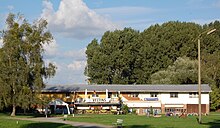Fermersleben harbor
The port of Fermersleben is a sport boat port on the Elbe in the Magdeburg district of Fermersleben .
Location and facilities
The port operated by the Buckau-Fermersleben water sports club is on the left, the western side of the Elbe at Elbe kilometer 322. The port is connected to the Elbe by a short connecting canal. The Wolfswerder extends to the north and the Katzenwerder to the south . To the west of the port area is the Salbker See II .
The port has boathouses for around 130 pleasure craft, a boathouse with a restaurant and a pleasure craft shed with canoe training pool. There is a slipway at the harbor for boats up to 14 meters in length. The total area of the association's premises around the port covers an area of 64,000 m². The Elbe Cycle Route runs through the port area .
history
Approximately in the area of the port, at the end of the Elbweg, the ferry , bathing establishment and restaurant of August and Paul Michaelis was already located .
In 1933 Michaelis acquired the historic chain steamer Gustav Zeuner, which was located south of today's harbor basin and served as a sports boat shed and restaurant. After a long period of deterioration, the Gustav Zeuner was renovated at the beginning of the 21st century and opened to the public in the Magdeburg trading port , north of Magdeburg's old town.
The still existing boathouse was built in 1924 and was originally called the barge at the port ahead of the today's groin in the stream. In 1945 the Prahm sank in its winter quarters in the customs port and was lifted in 1946. Until 1956 it served again as a floating base. It was then pulled ashore and set on two meter high pillars. The boathouse restaurant is still housed there today.
At an extraordinary general meeting of the sailing section of BSG Motor Südost Magdeburg in Buckauer Fichteheim on September 19, 1958, a perspective plan was decided which included the construction of the port. On January 24, 1959, at the annual general meeting in the small hall of the AMO in Buckau, the perspective plan was confirmed and also signed by the representatives of the sponsoring companies of the company sports association, the Karl Marx factory and the SKL . The plan also included the construction of a port facility measuring 80 by 60 meters.
After the building permit was available on March 6, 1959, the actual construction work began on March 15, 1959. It soon became apparent that the funds provided were insufficient for the intended earth moving. There was a meeting with the Mayor of Magdeburg, Philipp Daub . Daub recommended contacting the Soviet city commandant. In fact, in such a conversation , Kutuzov agreed to help and made a bulldozer available to the Soviet Army and driver Alexej for a long time . The caterpillar was used to move earth for 10 to 12 hours a day. At night, according to a requirement of the Soviet Army, the caterpillar was guarded by two club members. The caterpillar was also used in the course of the preparation of the puncture to the Elbe and got stuck in the mud. Trucks with capstan winches were hurriedly brought in from the SKL to salvage the sinking caterpillar. The withdrawal of the caterpillar ended tragically. Before he drove the caterpillar back through town in the direction of the Herrenkrug, Alexej had taken part in a drink . Intoxicated he ran a bead on the Schönebecker road into a construction site and got this arrest .
The necessary dredging work was carried out by an excavator from the neighboring gravel pit. 5200 m³ of overburden were excavated. The neighboring gravel dredging, to which the existence of the neighboring lakes can be traced back, helped. The gravel works received the excavated gravel free of charge. It is said to have been used to build the silos on the Fahlberg-List site . When the gravel to be dredged became clayey, the gravel works had to stop mining. Through relationships it was temporarily possible to procure an excavator from the Waterways Authority. The Salbke Reichsbahn repair shop provided 450 old railway planks for the construction of a temporarily necessary barbed dam , which were picked up from an old railway line by SKL trucks.
In the spring of 1960, 15 piers were built into the largely completed harbor basin. The port facility was inaugurated on May 7, 1960. The festive event began at 2 p.m., the entry of the boats from 6 p.m. In the aftermath, several shoals emerged within the port , which were removed using a floating dredger . The result was a harbor basin 140 meters long and 40 meters wide, which offered space for the 74 boats of the club at the time. 27,000 voluntary hours of work were done by the members of the association, other figures indicate the number as 17,160 hours. From 1960 onwards, sports arbors were built for members, especially to the northwest of the harbor basin.
The canoe teaching pool was completed in 1967.
Since the year 2000 the port has been operated by the Buckau-Fermersleben water sports club, which emerged from the sailing section of Fermersleber SV 1895 and which has followed on from a club tradition since 1911. In 2010 the port's 50th anniversary was celebrated. When the Elbe floods in 2013 , the port area was flooded from June 4, 2013. The port had previously been cleared.
literature
- Heinz Tietge, The Buckau-Fermersleben Water Sports Club Part 1, 1911–1961, Magdeburg 2011
Web links
Individual evidence
- ↑ Hans Treder, outline of the history of BSG Motor Magdeburg-Südost , 1987, page 17 ff.
Coordinates: 52 ° 5 ′ 58.5 ″ N , 11 ° 39 ′ 58.1 ″ E



